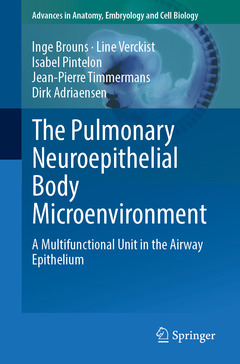The Pulmonary Neuroepithelial Body Microenvironment, 1st ed. 2021 A Multifunctional Unit in the Airway Epithelium Advances in Anatomy, Embryology and Cell Biology Series, Vol. 233
Auteurs : Brouns Inge, Verckist Line, Pintelon Isabel, Timmermans Jean-Pierre, Adriaensen Dirk

This monograph sheds new light on pulmonary sensory receptors. Diving into the pulmonary microenvironment, the book focuses on the role of pulmonary neuroepithelial bodies (NEBs) as potential receptors and effectors, able to store and release neurotransmitters. It explores NEBs as potential stem cell niche and highlights the multidisciplinary approach taken to identify and study NEBs, including functional morphological investigation, live cell imaging, genetic models, and laser microdissection combined with gene expression analysis.
Complexly organized NEBs are an integral part of the intrapulmonary airway epithelium of all air-breathing vertebrates. For decades a quest has been going on to unravel the functional significance of these intriguing structures that appear to be modified in the course of many pulmonary diseases. The NEB microenvironment (ME) is composed of organoid clusters of pulmonary neuroendocrine cells (PNECs) that are able to store and release neurotransmitters and are closely contacted by extensive nerve terminals, emphasizing a potential receptor/effector role and probable signalling to the central nervous system. PNECs are largely shielded from the airway lumen by a special type of Clara cells, the Clara-like cells, with potential stem cell characteristics. So far, functional studies of the pulmonary NEB ME revealed that PNECs can be activated by various mechanical and chemical stimuli, resulting in a calcium-mediated release of neurotransmitters. In the past decades, a number of publications have exposed NEBs as potential hypoxia sensors. Recent experimental evidence unveiled that the NEB ME is a quiescent stem cell niche in healthy postnatal lungs, and silencing may involve bone morphogenetic protein signalling mediated by vagal afferents. Only an integrated approach that takes all current information into account will be able to explain the full role of the pulmonary NEB ME in health and disease.
This highly informative and carefully presented book, provides insights for researchers, PhD students with an interest in (bio)medical and veterinary science, especially in the field of the autonomic innervation of the lung, chemo-and mechanoreceptors
Pulmonary sensory receptors.- The pulmonary NEB ME is a complex intraepithelial unit.- Studying the pulmonary NEB ME: a multidisciplinary approach.- Functional exploration of the pulmonary NEB ME.- Concluding remarks and future perspectives.- References.- ADDENDUM.
Dr. Inge Brouns obtained her PhD in 2002 under supervision of Profs. Adriaensen and Timmermans exploring the neurochemical coding and complex innervation pattern of pulmonary neuroepithelial bodies. She published >40 full papers mainly focusing on pulmonary sensory receptors and was first author of a previous edition published in 2012. She is currently working as coordinator for educational affairs within the Laboratory of Cell Biology & Histology.
Dr. Line Verckist obtained her PhD in 2018 under supervision of Dr. Brouns and Prof. Adriaensen. She focused her research on the microenvironment of pulmonary neuroepithelial bodies being a potential stem cell niche in the airway epithelium.
Dr. Isabel Pintelon obtained her PhD in 2007 under supervision of Prof. Adriaensen unraveling the neurochemical characteristics of sensory pulmonary and pleura receptors, and in situ functional imaging in ex vivo lung models. She is currently research manager and core facility manager within the Laboratory of Cell Biology & Histology.
Prof. Jean-Pierre Timmermans obtained his PhD in zoological sciences in 1987 and completed his habilitation in 1994. Since 2003, he is full professor at the Department of Veterinary Sciences of the University of Antwerp, where he is chair of the Laboratory of Cell Biology and Histology and director of the Antwerp Centre for Advanced Microscopy (ACAM). His main research interests relate to the autonomic nervous system, with specific attention to neuroimmune interactions in the gastrointestinal and respiratory tracts. His recent research activities are focused on the brain-gut-microbiome axis. He is (associated) editor of several international journals. He is a foreign member of the Deutsche Akademie der Naturforscher Leopoldina. He is a former president of the Royal Belgian Society for Microscopy, the International Society of Autonomic Neurosc
Date de parution : 05-2021
Ouvrage de 95 p.
15.5x23.5 cm



